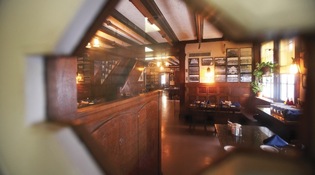 loading
loading
featuresWill Mory's survive? (And should it?)In post-WASP Yale, the bastion of the old-boy Old Blues is struggling to stay afloat. Mark Alden Branch ’86, executive editor of the Yale Alumni Magazine, is a member of Mory's.  Bob HandelmanMory's main dining room, seen through the window of the kitchen door. View full imageBefore he became general manager of Mory's in 2002, Jim Shumway spent 30 years in the hotel business. His first job was at Colonial Williamsburg, the living museum of eighteenth-century life in Virginia. But he didn't just work in the hotel. "I also was an apprentice engraver in a jewelry shop," says Shumway. "I've had a lifelong interest in history and interpreting it to the public." What better qualification for running Mory's? The 147-year-old campus saloon has become a kind of living museum of the old Yale. Governed since 1912 as a private club, with a volunteer board whose resistance to change is both a running joke and an article of faith, Mory's is a monument to the bygone tastes of a WASP male ruling class at play: ostentatiously humble in decor (and food quality), awash in alcohol, and adorned with totems of athletic competition and middlebrow music, two things Yale culture held dear. Club president Cheever Tyler ’59 likes to refer to Mory's as a "museum of the evocative." The trouble is: how can a museum survive in the restaurant business? Beset by increasing union labor costs, strict state enforcement of the minimum drinking age, and ever-improving competition from new restaurants in New Haven, Mory's is in crisis. The club has run annual deficits of around $100,000 or more for at least three of the past four years, and its small endowment is dwindling. Mory's still has a core of devoted fans, and the club has plans to try to broaden its appeal. But after weathering decades of upheaval in Yale's social order, has Mory's finally reached closing time?
|
|